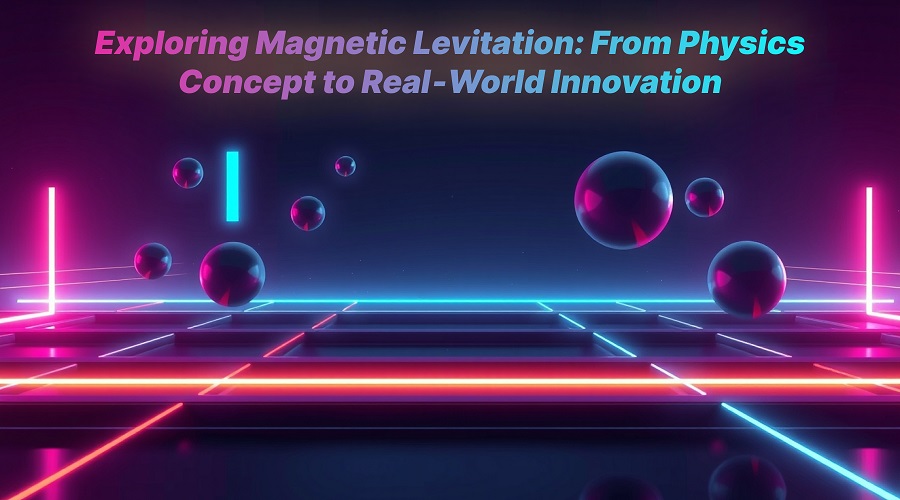Imagine something floating in mid‑air without strings or wires. It sounds like magic, but that is exactly what magnetic levitation enables. In this blog we will take a journey from theory to practice, exploring how this idea works, where it is used, what the challenges are, and what the future holds.
What is Magnetic Levitation
At its heart, magnetic levitation is the process of using magnetic forces to counteract gravity so that an object can hover without touching anything. Physics tells us that magnets can attract or repel depending on polarity, and materials like superconductors or diamagnetic substances respond in useful ways. For example, superconductors can expel magnetic fields (Meissner effect), which helps in making stable levitation possible.
Key Physics Principles
Magnetic forces vs gravitational force: To levitate an object, magnetic repulsion or attraction must balance weight.
- Diamagnetism and superconductivity: Diamagnetic materials create a weak repulsion to magnetic fields. Superconductors not only strongly repel but also “lock in” magnetic field lines under certain conditions making levitation stable.
- Active and passive stabilization: Passive uses fixed magnetic fields and special materials. Active uses sensors and feedback to adjust and maintain stability.
Real‑World Innovations & Applications
Here are some of the real ways magnetic levitation is already changing things.
- High‑speed trains: Systems in Japan (SCMaglev) use superconducting magnets to lift trains off tracks and travel at speeds over 600 km/h. This reduces friction, allowing smoother and faster rides.
- Frictionless sensors and platforms: A recent breakthrough used graphite‑based materials to build a floating platform that requires no external power. It hovers over a grid of magnets, and since the material is modified to be electrically insulating it avoids energy loss via currents. Useful for extremely precise measurement tools.
- Space launch and futuristic transport: There are proposals such as StarTram which imagine using magnetic levitation assisted systems to launch payloads into space via evacuated tubes.
- Fusion reactors & plasma containment: Experiments like the Levitated Dipole Experiment (LDX) used free‑floating magnetic dipoles to confine plasma for fusion research, levitating large superconducting magnets in cryogenic conditions.
- Optimized maglev design via advanced materials & algorithms: Recent research shows that using genetic algorithms, better materials, and improved magnetic layouts can make superconducting maglev systems more cost‑efficient and reliable.
Benefits and Challenges
Here some important benefits and challenges are also mentioned about it:
Benefits:
- Less mechanical friction means less wear and tear, more speed, higher efficiency
- Smooth motion, less noise
- Potential for energy saving over long periods once system is optimized
Challenges:
- Energy and cost for cooling superconductors (often very low temperatures)
- Building stable magnetic fields and keeping systems stable under disturbances
- Manufacturing materials that are strong, light, and maintain performance
- Safety, alignment, infrastructure costs are high especially for large systems like train networks or space launch schemes
- The SCMaglev prototype in Japan reached a world record of about 603 km/h for crewed rail travel.
The new graphite platform developed by the Okinawa Institute floated without external power and showed that by coating graphite beads with insulating silica the energy loss due to electrical currents was minimized.
In the LDX fusion experiment a superconducting coil weighing about 560 kilograms was levitated at about 1.6 meters using magnetic forces, under cryogenic conditions (below 10 K) and producing peak magnetic fields of ~5.7 Tesla.
The Future: What’s Next
Better materials: superconductors that work at higher temperatures, diamagnetic materials with stronger effects.
Smaller, compact devices: sensors, drones, precision tools using levitation in tiny scales.
Integration: merging with robotics, quantum sensing, aerospace.
Infrastructure scale‑up: more maglev train lines, perhaps orbital launch systems, and maybe urban transport pods (lightweight hover systems) for short distances.
Conclusion
Magnetic levitation is no longer a futuristic fantasy. It is a physics concept with real world innovation all around us. From trains gliding at astonishing speeds to floating sensors so precise they seem to defy what we thought possible. Yes there are technical hurdles like cooling, costs, materials but researchers are steadily overcoming them. As those challenges fall away expect to see more hovering, floating and frictionless motion in our daily lives.
As a researcher exploring magnetic levitation, I’ve seen how this concept evolves from physics theory to real-world innovation. Working closely with a research assistant allows me to design experiments, analyze data, and uncover practical applications that can transform industries. Engaging in this research not only deepens understanding but also opens doors to groundbreaking solutions, making every discovery a step toward tangible technological impact.
FAQs
1. How stable is levitation?
Stability depends on design. Passive systems using superconductors can self stabilize, but disturbances (vibration, temperature changes) can destabilize. Active systems add sensors and feedback control to help maintain stability.
2. Do you need extreme cooling for all levitating systems?
Not always. Superconducting methods do require very low temperatures. But some diamagnetic materials levitate at room temperature under strong magnetic fields, although usually with weaker forces or over small distances.
3. Is this technology energy efficient?
Over time, yes. While initial setup and cooling (if required) consume energy, the lack of mechanical friction can yield efficiency gains especially in high speed or continuous operation systems.
4. Are there safety risks?
Yes. Strong magnetic fields can interfere with electronics or medical implants. Cryogenic systems carry risks. Also, levitating heavy objects means failing supports or power can lead to sudden drops or mechanical stress.
5. When will we see more widespread adoption?
Already in some countries. In the next decade or two more maglev train lines are expected. Sensor and materials research is advancing fast so more compact uses could enter markets sooner. Large scale applications (space launch, global networks) will take longer due to cost and infrastructure demands.





Comments